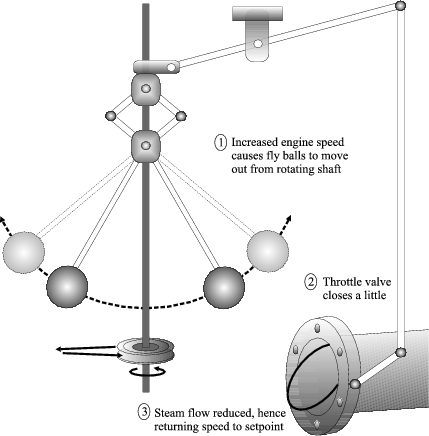|
You are here :
Control System Design - Index | Book Contents |
Chapter 1
| Section 1.2
1. The Excitement of Control Engineering
1.2 Motivation for Control Engineering
Feedback control has a long history, which began with the early
desire of humans to harness the materials and forces of nature to
their advantage. Early examples of control devices include
clock-regulating systems and mechanisms for keeping wind-mills
pointed into the wind.
A key step forward in the development of control occurred during
the industrial revolution. At that time, machines were developed
that greatly enhanced the capacity to turn raw materials into
products of benefit to society. The associated machines,
specifically steam engines, involved large amounts of power, and
it was soon realized that this power needed to be
controlled in an organized fashion if the systems were to
operate safely and efficiently. A major development at this time
was Watt's fly-ball governor. This
device regulated the speed of a steam engine by throttling the
flow of steam; see Figure 1.1. These devices
remain in service to this day.
Figure 1.1:
Watt's fly-ball governor
 |
The World Wars also led to many developments in control
engineering. Some of these were associated with guidance systems
whilst others were connected with the enhanced manufacturing
requirements necessitated by the war effort.
The push into space in the 1960's and 1970's also depended on
control developments. These developments then flowed back into
consumer goods, as well as into commercial, environmental, and
medical applications. These applications of advanced control have
continued at a rapid pace. To quote just one example from the
author's direct experience, centre-line thickness control in
rolling mills has been a major success story for the application
of advanced control ideas. Indeed, the accuracy of centre-line
thickness control has improved by two orders of magnitude over the
past 50 years, thanks, in part, to enhanced control. For many
companies, these developments were central not merely to increased
profitability but even to remaining in business.
By the end of the twentieth century, control has become a
ubiquitous (but largely unseen) element of modern society.
Virtually every system we come in contact with is underpinned by
sophisticated control systems. Examples range from simple
household products (temperature regulation in air-conditioners,
thermostats in hot-water heaters, etc.), to more sophisticated
systems, such as the family car (which has hundreds of control
loops), to large-scale systems (such as chemical plants, aircraft,
and manufacturing processes). For example, Figure
fig:kellogg shows the process schematic of a Kellogg
ammonia plant. There are about 400
of these plants around the world. An
integrated chemical plant of the type shown in
Figure 1.2 will typically have many hundreds of control
loops. Indeed, for simplicity, we have not shown many of the
utilities in Figure 1.2, yet these also have
substantial numbers of control loops associated with them.
Many of these industrial controllers involve cutting edge
technologies. For example, in the case of rolling mills
(illustrated in Figure 1.3), the control system
involves forces on the order of 2,000 tonnes, speeds up to 120
km/hour, and (in the aluminum industry) tolerances of 5
micrometers or 1/500th of the thickness of a human hair! All of
this is achieved with precision hardware, advanced computational
tools, and sophisticated control algorithms.
Beyond these industrial examples, feedback regulatory
mechanisms are central to the operation of biological systems,
communication networks, national economies, and even human
interactions. Indeed, if one thinks carefully, control in one form
or another can be found in every aspect of life.
In this context, control engineering is concerned with designing,
implementing, and maintaining these systems. As we shall see
later, this is one of the most challenging and interesting areas
of modern engineering. Indeed, to carry out control successfully,
one needs to combine many disciplines, including modeling (to
capture the underlying physics and chemistry of the process),
sensor technology (to measure the status of the system), actuators
(to apply corrective action to the system), communications (to
transmit data), computing (to perform the complex task of changing
measured data into appropriate actuator actions), and interfacing
(to allow the multitude of different components in a control
system to talk to each other in a seamless fashion).
Thus, control engineering is an exciting multidisciplinary subject
with an enormously large range of practical applications.
Moreover, interest in control is unlikely to diminish in the
foreseeable future. On the contrary, it is likely to become ever
more important, because of the increasing globalization of markets
and environmental concerns.
|